

Skylon ‘spaceplane economics stack up’ 29 May 2014Last updated at 05:38 ET Skylon is the result of 30 years' development and probably about 100m euros (£80m) of investment so far.
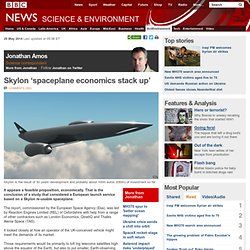
Transportation Design - formquadrat.com. Nuclear Propulsion in Space (1968) NASA Eagleworks Space Warping and Quantum Vacuum Plasma Thruster - Propellentless propulsion. Popular Science discusses the Harold space warping project at NASA and Quantum Vacuum Plasma Thruster Quantum Vacuum Plasma Thruster White shows me into the facility and ushers me past its central feature, something he calls a quantum vacuum plasma thruster (QVPT).

The device looks like a large red velvet doughnut with wires tightly wound around a core, and it's one of two initiatives Eagleworks is pursuing, along with warp drive. VASIMR: Zubrin défie Chang Diaz d’en débattre avec lui. Cubesats explained and why you should build one. Ever wanted to make your own satellite?

Now you can. Building a Cubesat is affordable and you may even qualify for a free ride from NASA. What are Cubesats? A CubeSat is a small satellite in the shape of a 10 centimeter cube and weighs just 1 kilogram. That’s about 4 inches and 2 pounds. Plasma thruster could propel small satellites into deep space for cheap. Interstellar chemistry makes use of quantum shortcut. Molecules floating in the dark, cold vacuum of interstellar space can exploit quantum mechanics to react and produce more complex chemicals, a new study suggests.
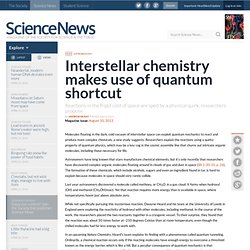
Researchers explain the reactions using a quirky property of quantum physics, which may be a key cog in the cosmic assembly line that churns out intricate organic molecules, including those necessary for life. Astronomers have long known that stars manufacture chemical elements, but it’s only recently that researchers have discovered complex organic molecules floating around in clouds of gas and dust in space (SN 1/30/10, p. 26). The formation of these chemicals, which include alcohols, sugars and even an ingredient found in tar, is hard to explain because molecules in space should very rarely collide. Last year astronomers discovered a molecule called methoxy, or CH3O, in a gas cloud. Dennis Bushnell on Space Exploration. Dr.
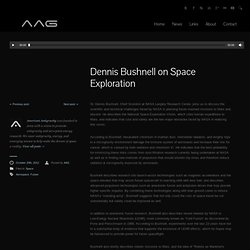
Dennis Bushnell, Chief Scientist at NASA Langley Research Center, joins us to discuss the scientific and technical challenges faced by NASA in planning future manned missions to Mars and beyond. He describes the National Space Exploration Vision, which cites human expeditions to Mars, and indicates that cost and safety are the two major obstacles faced by NASA in realizing this vision. According to Bushnell, hexavalent chromium in martian dust, interstellar radiation, and lengthy trips in a microgravity environment damage the immune system of astronauts and increase their risk for cancer, which is caused by both radiation and chromium VI.
Robert Bussard on Fusion Power. Dr.
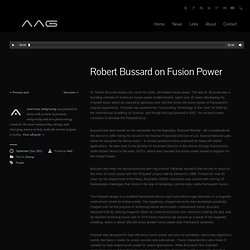
Robert Bussard shares his vision for clean, affordable fusion power. The late Dr. Bussard was a founding member of America’s fusion power establishment, spent over 20 years developing the Polywell fusor, which he claimed to generate over 100,000 times the fusion power of Farnsworth’s original experiments. Polywell was awarded the “Outstanding Technology of the Year” for 2006 by the International Academy of Science, and though Bussard passed in 2007, his research team continues to develop the Polywell fusor. Warp drive looks more promising than ever in recent NASA studies. "Interstellar travel may still be in its infancy, but adulthood is fast approaching, and our descendants will someday see childhood's end.

" The Starflight Handbook The first steps towards interstellar travel have been taken, but the stars are very far away. Voyager 1 is about 17 light-hours distant from Earth and is traveling with a velocity of 0.006 percent of light speed, meaning it will take about 17,000 years to travel one light-year. Fortunately, the elusive "warp drive" now appears to be evolving past difficulties with new theoretical advances and a NASA test rig under development to measure artificially generated warping of space-time. "PROPULSION" Calling All Rocketeers!
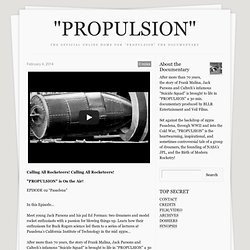
Calling All Rocketeers! "PROPULSION" is On the Air! EPISODE 02 “Pasadena” In this Episode… The Prometheus Gas Turbine Project Introduces A New Electric Gas Turbine. Firestar Selected for SBIR Contract for Green Propulsion System. On Thursday, NASA announced the selection of 39 proposals for Small Business Innovation Research (SBIR) Phase II awards.
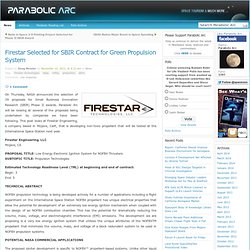
Parabolic Arc will be looking at several of the proposals being undertaken by companies we have been following. This post looks at Firestar Engineering, a company based in Mojave, Calif., that is developing non-toxic propellant that will be tested at the International Space Station next year. Firestar Engineering, LLC Mojave, CA. Hypersonic X-43A Takes Flight. Pegasus booster rocket ignites to send the X-43A on its record setting flight on Nov. 16, 2004.
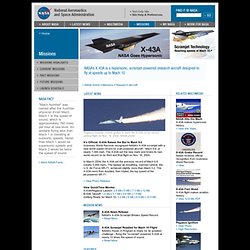
X-43A : l'avion le plus rapide du monde n'emporte pas de comburant ! Japan Aerospace Exploration Agency. Coopération avec la Jaxa. Dans le cadre d’un accord de coopération concernant l'échange de personnel entre le CNES et la JAXA, l'agence spatiale japonaise, le Centre spatial de Toulouse accueillera, le 21 novembre prochain, un ingénieur Japonais pour une durée d’1 an. Cheap 'Plasma Jet' for Space Propulsion Aim of Kickstarter Campaign. Travel to the moon, asteroids, Mars and other nearby destinations could become more affordable if a Virginia-based company achieves its goal of building cheaper electric space propulsion.
The firm, called HyperV Technologies Corp., has started a crowd-funding campaign on the website Kickstarter to pay for the project, called a plasma jet thruster. The 8-year-old company, which officials said collaborates with several United States laboratories in its research, has just two days left in the campaign to raise its goal of $69,000. Power on the cheap HyperV officials said their experience in building plasma accelerators will make their proposed thruster technology less expensive, without sacrificing the power needed to propel spacecraft into the solar system and beyond.
Voxalead - AFP Vidéos - Français. New and Improved Antimatter Spaceship for Mars Missions. New and Improved Antimatter Spaceship for Mars Missions Most self-respecting starships in science fiction stories use antimatter as fuel for a good reason – it’s the most potent fuel known. While tons of chemical fuel are needed to propel a human mission to Mars, just tens of milligrams of antimatter will do (a milligram is about one-thousandth the weight of a piece of the original M&M candy).
Image right: A spacecraft powered by a positron reactor would resemble this artist's concept of the Mars Reference Mission spacecraft. Credit: NASA Antimatter is sometimes called the mirror image of normal matter because while it looks just like ordinary matter, some properties are reversed. When antimatter meets matter, both annihilate in a flash of energy.
Orbital Begins Antares Rocket Operations - Commercial Space Watch. Orbital Sciences Corporation (NYSE: ORB), one of the world's leading space technology companies, today announced that has it has commenced Antares launch vehicle operations at the liquid-fuel launch complex at the Mid-Atlantic Regional Spaceport (MARS). Following a four-year design, development, construction, test and inspection process, the Virginia Commercial Space Flight Authority (VCSFA), which oversees MARS, has authorized Orbital to begin on-pad operations leading up to flight demonstrations of its Antares medium-class launch vehicle and Cygnus cargo logistics spacecraft, the vehicles Orbital will use to fulfill a $1.9 billion NASA contract to deliver essential cargo to the International Space Station (ISS). The MARS launch complex is located at NASA's Wallops Flight Facility in eastern Virginia and is owned and operated by MARS, under the auspices of the VCSFA, which receives its funding from the Commonwealth of Virginia.
About Orbital. NASA Building a Better Solid Rocket Booster for Space Launch System Rocket. The largest and most powerful solid rocket booster ever built for flight is being assembled for NASA’s Space Launch System at ATK Space Systems in Brigham City, Utah, incorporating new cost-savings measures. The SLS will launch NASA’s Orion spacecraft and other payloads beyond low Earth orbit, and provide an entirely new capability for human exploration.
Although similar to the solid rocket boosters that helped power the space shuttle to orbit, the five-segment SLS boosters include several upgrades and improvements implemented by NASA and ATK engineers. In addition, the SLS boosters will be built more affordably and efficiently than shuttle boosters, incorporating new and innovative processes and technologies. ATK moves a segment of the solid rocket booster for assembly at the company's facility in Promontory, Utah. Fly Over California Alongside a Space Shuttle! Want to stay on top of all the space news? Follow @universetoday on Twitter A view of Endeavour and SCA over California from one of NASA’s F/A-18 chase planes (NASA/DFRC) We’ve shared several videos from Endeavour’s trip to Los Angeles last week, taken by excited spectators along various portions of the flight path, but what was it like for the crews of the two NASA F/A-18 chase planes that accompanied the orbiter and SCA every step of the way?
Watch the video below, and put yourself in the pilot’s seat… Shared by NASA’s Dryden Flight Research Center, the video shows footage taken from the viewpoint of one of the chase planes as Endeavour was ferried aboard a Shuttle Carrier Aircraft from Edwards Air Force Base to Los Angeles International Airport. Along the way SCA pilots Jeff Moultrie and Bill Rieke, both from NASA’s Johnson Space Center, guided the 747 over such landmarks as the State Capitol in Sacramento, the Golden Gate Bridge at San Francisco, and NASA’s Ames Research Center. Nuclear Propulsion for Mars Trip. Will Fusion Propulsion for Exploration of the Solar System Occur in Our Future?
New Spacecraft Propulsion Method Could Be Out Of This Solar System. From universities, journals, and other organizations. Moteurs spatiaux : le plasma a le vent en poupe. La Nasa investit dans la propulsion hypersonique. La Nasa investira 700 millions de dollars dans les cinq prochaines années en recherches technologiques en propulsion hypersonique.
Les visiteurs du salon annuel AirVenture Air Show de l' Experimental Aircraft Association pourront découvrir, en primeur, les maquettes du programme hypersonique Hyper-X de la Nasa. Petite histoire du moteur plasmique à effet Hall. SABRE (rocket engine) Brevard Times - Space: Secret 'Mini Space Shuttle' X-37B Set For October Launch. CAPE CANAVERAL, Florida -- The X-37B Orbital Test Vehicle (OTV), the Air Force's unmanned, reusable space plane, is scheduled to launch aboard a United Launch Alliance Atlas V booster rocket from Cape Canaveral Air Force Station on October 25, 2012.
Une jeune égyptienne invente un nouveau système de propulsion spatial basé sur la physique quantique. Une jeune (adolescente) et précoce physicienne, Mustafa Aïcha, vient de breveter un nouveau système qui pourrait propulser des vaisseaux spatiaux aux confins de l’univers sans utiliser une goutte de carburant. Image d’entête : une représentation artistique et mystique d’un moteur ionique. *L’information provient d’une source (gouvernementale) au demeurant sérieuse, mais votre Guru émet quelque réserve, ne maitrisant pas les méthodes de traitement des découvertes scientifiques en Égypte.
Je m’applique généralement sur des publications peer-reviewed et cela n’en est pas une. SXT-A Iron Speed Space Tourism by Oscar Viñals. XCOR Lynx: Supersonic Plane To Fly Between NYC And Tokyo In 90 Minutes (PHOTOS) SpaceShipTwo Fitted With Rocket Propulsion System. Lien - Les États-Unis voulaient une soucoupe volante.